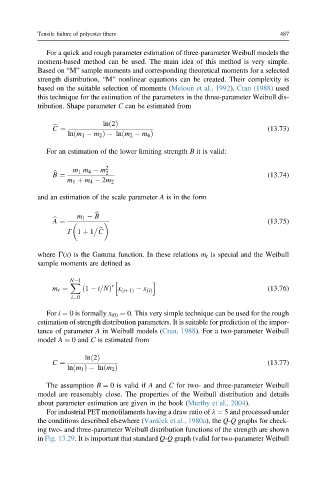Page 514 - Handbook of Properties of Textile and Technical Fibres
P. 514
Tensile failure of polyester fibers 487
For a quick and rough parameter estimation of three-parameter Weibull models the
moment-based method can be used. The main idea of this method is very simple.
Based on “M” sample moments and corresponding theoretical moments for a selected
strength distribution, “M” nonlinear equations can be created. Their complexity is
based on the suitable selection of moments (Meloun et al., 1992). Cran (1988) used
this technique for the estimation of the parameters in the three-parameter Weibull dis-
tribution. Shape parameter C can be estimated from
lnð2Þ
C ¼ (13.73)
b
lnðm 1 m 2 Þ lnðm 2 m 4 Þ
For an estimation of the lower limiting strength B it is valid:
m 1 m 4 m 2 2
B ¼ (13.74)
b
m 1 þ m 4 2m 2
and an estimation of the scale parameter A is in the form
m 1 B
b
(13.75)
b
A ¼
G 1 þ 1 C
b
where G(x) is the Gamma function. In these relations m r is special and the Weibull
sample moments are defined as
N 1
X r h i
m r ¼ ð1 i=NÞ x x (13.76)
ðiþ1Þ ðiÞ
i¼0
For i ¼ 0 is formally x (0) ¼ 0. This very simple technique can be used for the rough
estimation of strength distribution parameters. It is suitable for prediction of the impor-
tance of parameter A in Weibull models (Cran, 1988). For a two-parameter Weibull
model A ¼ 0 and C is estimated from
lnð2Þ
C ¼ (13.77)
lnðm 1 Þ lnðm 2 Þ
The assumption B ¼ 0 is valid if A and C for two- and three-parameter Weibull
model are reasonably close. The properties of the Weibull distribution and details
about parameter estimation are given in the book (Murthy et al., 2004).
For industrial PET monofilaments having a draw ratio of l ¼ 5 and processed under
the conditions described elsewhere (Vaní cek et al., 1980a), the Q-Q graphs for check-
ing two- and three-parameter Weibull distribution functions of the strength are shown
in Fig. 13.29. It is important that standard Q-Q graph (valid for two-parameter Weibull

